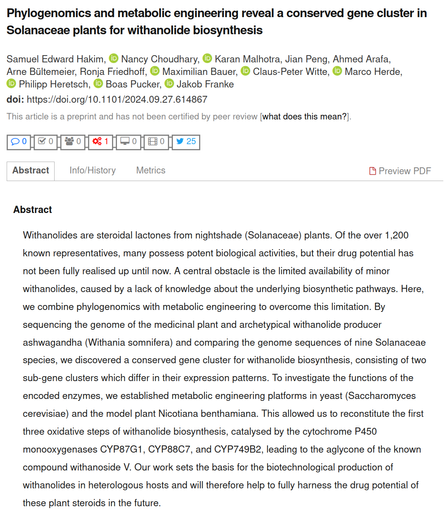#comparativegenomics
Microbial Genomics and Metagenomics (MGM) Workshop Learn all about IMG/M and other @jgi.doe.gov data systems for #microbiology #metagenomics #microbiome #bioinformatics #comparativegenomics at our 5-day workshop April 28-May 2, 2025 in Berkeley Registration is now open: mgm.jgi.doe.gov
Excited to announce the discovery of a withanolide biosynthetic gene cluster! A huge achievement from our collaboration with the Franke Lab. Explore the findings here:
https://doi.org/10.1101/2024.09.27.614867
#ComparativeGenomics #Biochemistry
@tubraunschweig @PuckerLab @unihannover
CGV paper is out. Alignments are added per request, and I guess the team would love to hear any user feedback. :) #comparativegenomics #NCBI
https://doi.org/10.1371/journal.pbio.3002405
What is SFASTA?
Genomic and bioinformatic-adjacent sequences (RNA, Protein, Peptides) are stored as FASTA files. Sequencing reads off a machine are stored as FASTQ files, adding a quality score associated with each nucleotide. Currently, these are non-human-readable plaintext files. As sequencing increases, we need to be able to process many more gigabytes and terabytes of files rapidly and with random access (currently solved by bgzip/tabix). becomes incredibly important.
SFASTA, my focus-on-random-access-speed FASTA/Q format replacement, has worked well for medium and large FASTA files, defining large as anything smaller than NT nucleotide database (~203Gb gzip-9 compressed, but likely larger whenever you are reading this). Small files did not benefit from stream compression and crazy indices, although the time cost for small files is irrelevant. But the conversion of nt to SFASTA took an inordinate amount of time, and reading the index into memory did as well. While still smaller and faster than gzip-9, this does not accomplish what I want.
Why?
FASTA files are frequently compressed with an outdated, slow, inefficient compression algorithm (gzip). Modern alternatives provide better compression ratios, decompression ratios, and faster throughput. The speed of reading FASTA files is quite important, with multiple tools that try to be the fastest. Clearly, this is an unsolved problem, and sticking to a text-based, non-human-readable format is a choice that only occurs due to the momentum of existing tools.
Genomics is moving to “Genomics at scale” and away from single-genome analyses. A flat file format adds unnecessary processing time to query hundreds of genomes instantly. For my own usage, I’d like to be able to query NT and fill up the GPU with random, on-the-fly examples. This is entirely achievable with modern computers but not with outdated file formats and compression.
What does SFASTA mean?
SFASTA previously stood “Snappy FASTA” as it used the Snappy algorithm, but now it uses ZSTD. The name remains as the command remains sfa, which can be typed with one hand on the home line on a standard keyboard.
Further Speed-ups
So, it’s clear my custom-built index was a failure. Enter B+-tree. While fighting post-COVID brain fog, I eventually managed to build a naive implementation. My benchmarks for creating a tree with 128 million key/value pairs threatened to take over 20 hours (for 20 samples, so 1 hour each). Hacking away at that, I did shrink it, but only some. Then, I modified a copy to use the sorted-vec crate. Finally, while reading further up on the topic, I discovered fractal trees, which merely add a buffer to each node and process it when calling for a flush or exceeding the buffer size. I am now within a minute of creating such a large index. For this implementation, the fractal tree uses sorted-vecs as the key vector.
For B+ trees and fractal trees, the order of the nodes (how many children each node can have) is incredibly important. For creating trees, an order of 32 seems to be the sweet spot (this is tested on u64 as both keys and values). For fractal trees, 64 with a larger buffer seems to be the sweet spot. The figure below shows the fastest order, 64, and buffer 128. The image below is for 1 million items.
Text is difficult to read, but the number is the order, and for fractal trees, the second number is the buffer size.
The Big Tree
My NT test dataset is a bit over 128 million entries, u64 range 0 to 128_369_206, with keys and values as the xxh3 hashed integer. You can see the spread below. Here the larger buffer size (up to 256) performs the best, but many are in the less than a minute sweet spot.
Searching the Tree
Now that building a tree for NT takes under a minute, compressing and queueing the nucleotide sequences and IDs into the file will be the bottleneck for creation. Building the tree is also a one-time cost, so it is not the highest priority. The focus now is searching the tree, which will happen quite frequently depending on the final use case.
I’m just now getting to start on this, but as you can see below, where input is the order of the nodes, a larger order decreases the time to find a key. This is an even better sign for the fractal trees, as they are more efficient with larger orders. The image below shows very little difference, with sorted vec having a bit of a slowdown. I have no idea why, possibly due to a line of code that did not change as I’m simultaneously playing around with three versions. As my fractal tree implementation uses sorted-vec, these results are quite equivalent. The search code is nearly identical. This is the next step.
Here, the x-axis is node order, with tests for 16, 32, 64, and 128.
What Hasn’t Worked
- 2bit/4bit nucleotide encodings – did not increase throughput or decrease on-disk size. Still worth further investigation.
Immediate Next Steps
As this is a write-once file format, at least at this stage, I plan to do the following:
- Smaller struct for read-only mode, i.e., buffer is no longer needed
- Benchmark sorted-vec against Eytzinger order
- Load only parts of the tree from disk, have efficient serialization
- Possibly try a bumpalo arena for querying the on-disk tree
- Batch insertion – Maybe this was all for naught
- Stream VBytes storage for keys/values of tree?
Ultimate Goals
- LD_PRELOAD to work with existing tools
- Python library
- C API
I’ve been programming in Rust for a couple of years and have experimented with many different things, including the bevy game engine. I would still argue I’m a middling skilled Rust developer, as I’m also a population geneticist. Thus, some weeks are spent without writing a single line of code or only writing in Python for statistical analysis. Thus, I expect much room for improvement, although I’m proud of where I’ve gotten this so far.
Plots made with criterion.
Exciting news!
The Rat Genome Database rgd.mcw.edu
is pleased to announce the release of an updated #Cardiovascular Disease Portal featuring data and tools to support cardiovascular disease research. To learn more, https://rgd.mcw.edu/wg/updated-cvd-portal/ #comparativegenomics
I'm wondering if anybody has tried (considered even) #tabix indexing #PAF files. These files are used for #ComparativeGenomics, so you'd need two indexes, one on the reference and one on the query. Conceptually it makes sense to me but I've not seen it done anywhere.
Delighted to share our new Science #EvolgenPaper! https://www.science.org/doi/10.1126/science.abn3107
We introduce #TOGA, a #ComparativeGenomics method that combines the detection of orthologous genes with gene annotation. In plain words, TOGA can take advantage of a well-annotated #genome and transfer its annotations to a genome of a different species (e.g., from the human genome to that of a squirrel). 1/2
We hope that the comparative genomics analyses made available through this study will provide a route towards the application of genomics-informed conservation programmes across the great diversity of invertebrate species. A big thank to all the amazing people from the Darwin Tree of Life Project that made this reserch possible! #biodiversity #conservation #comparativegenomics #PacBio #DarwinTreeofLife #Ensembl #emblebi #sangerinstitute #wellcometrust
A bit more detailed on how to navigate genome alignments on CGV or the Comparative Genome Viewer (and you can request to add alignments for any pairs of chromosome-level assemblies if they are on NCBI) (and they are not too far apart) (and with similar ploidy levels, for now) :) #comparativegenomics #NCBI
https://youtu.be/_TA86Tu1N0c
Comparative Genomics Viewer by #NCBI - the browsing experience is quite cool, and I guess more species pairs will be added (they are accepting requests) :) #comparativegenomics
https://ncbiinsights.ncbi.nlm.nih.gov/2023/02/22/cross-species-cgv/
I’m a Post-doc at the University of Oxford, working on the evolution of bacterial genomes and pangenomes. I’m interested in bacterial cooperation and ecology, and how these might interact with horizontal gene transfer.
I’m on the train to Manchester for the #MicroEvo22 meeting, where I’ll be presenting a poster (no. 17). Looking forward to seeing lots of you there!
GERP scores are frequently used to classify and assess the prevalence of deleterious mutations, but what are the limitations of this approach and how sensitive is it to what species are included in the underlying alignment? I was wondering about this and found this nice paper from 2020 that I had missed at the time, and that investigates these issues using simulations.
Here's the paper by Huber, Kim and Lohmueller:
https://journals.plos.org/plosgenetics/article?id=10.1371/journal.pgen.1008827
My #Introduction: I'm Beth, a #NewPI and Assistant Professor of #Genetics at Mount Royal University in Calgary. I'm interested in #Bioinformatics, #Genomics, #CellBiology, #Microbiology, #eDNA, #MolecularEcology, #ComparativeGenomics, the #AthabascaOilSands and #Protists. Outside of work, I divide my time between video games, crafting, and being the least outdoorsy person within driving distance of the Canadian Rockies.
#rnaseq #comparativegenomics folks ...
So, you have two species, each with its own reference genome. You want to compare #transcript abundance between the species using with RNA-seq reads. What do you do?
Hey #ScienceMastodon,
Do you work on #Evolution #Adaptation #Speciation #Genomics #Phylogenetics #PopGen #ComparativeGenomics?
I WANT TO FOLLOW YOU!
Like this so that I can find you
#introduction I am a new Bioinformatics data wrangler and a contractor for NCBI, trying to help them to develop the Comparative Genomics Resources. Until earlier this year, I studied mostly genomes of "extremophyte" plants that thrive under harsh environments using #comparativegenomics approaches: e.g. to identify lineage(s)-specific modifications of gene copy numbers and gene regulatory networks among the "extremophytes" and their close relatives.


